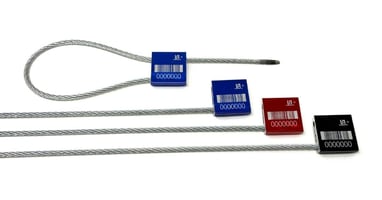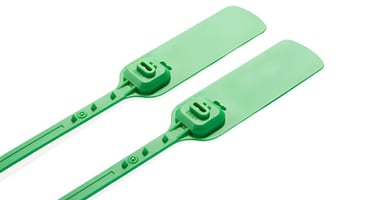Security seals play an instrumental role in ensuring the integrity of goods during transit. From...
How To Color-Code Bolt Seals for Supply Chain Management

Color coding systems have the power to transform chaotic supply chains into organized, efficient operations. When you implement strategic color schemes for your bolt seals, you create visual cues that streamline identification, reduce errors, and enhance security protocols across your entire logistics network.
Use this comprehensive guide to learn how to color-code bolt seals for supply chain management. By following these expert tips, you can eliminate guesswork by providing instant visual recognition.
Standard Security Bolt Seals
Standard security bolt seals use basic color coding to indicate routine shipping operations and general security levels. You can implement a straightforward system using primary colors to distinguish between operational categories.
Blue Seals
Blue seals often designate standard commercial shipments that require basic security protocols. These shipments follow regular inspection schedules and standard handling procedures. Without additional verification steps, your warehouse teams can quickly identify these containers and apply appropriate processing workflows.
Red Seals
Red seals signal elevated attention requirements, though not necessarily maximum security. You might use red coding for time-sensitive deliveries, temperature-controlled shipments, or cargo requiring special handling equipment. This color immediately alerts personnel that additional care or expedited processing applies to these particular containers.
Green Seals
For approved or cleared shipments that have passed initial security screenings, green seals work well. Once customs officials or security personnel verify container contents, green seals indicate that no further delays should occur during the remaining transport phases.
Yellow Seals
You can use yellow seals to designate containers awaiting inspection or verification. This color coding helps logistics coordinators identify which shipments require additional documentation or clearance before proceeding to their next destinations.

High-Security Bolt Seals
High-security bolt seals demand more sophisticated color coding systems that reflect stringent security protocols and regulatory compliance requirements. These seals protect valuable cargo, sensitive materials, or shipments crossing international borders where security breaches carry severe consequences.
Black seals
Black seals commonly represent maximum security classifications and indicate that only authorized personnel with proper clearances may handle these containers. You should restrict access to black-sealed containers and maintain detailed logs of every interaction. These seals often protect military supplies, precious metals and pharmaceuticals requiring constant surveillance.
Orange seals
Orange seals work effectively for hazardous materials that pose safety risks during transport. This bright, attention-grabbing color ensures that handlers recognize containers requiring specialized safety equipment and procedures. Your teams can quickly identify these shipments and apply appropriate protective measures without delays.
Purple seals
Purple seals can designate shipments from government or regulatory agencies that follow specific compliance protocols. These containers often require special documentation, routing restrictions, or handling procedures mandated by federal regulations. The distinctive purple color encourages compliance throughout the supply chain.
White seals
White seals serve well for medical or pharmaceutical shipments requiring sterile handling procedures. The clean, clinical appearance of white reinforces the importance of maintaining sanitary conditions and appropriate storage temperatures during transport.
Tamper-Evident Bolt Seals
These specialized seals require color coding that maintains clear operational classifications and immediately reveals attempts at unauthorized access. Your color system should make tampering obvious but still allow for effective shipment categorization.
Silver Seals
Since their reflective properties clearly show scratches, cuts, or other damage, silver seals provide excellent tamper evidence. You can use silver coding for high-value electronics and luxury goods. The metallic finish makes any tampering attempts visible during inspections.
Neon Seals
Bright pink, electric blue, and other neon colors make it easy to spot missing or damaged seals from considerable distances. With these seals, your security teams can perform visual inspections quickly without needing to approach every container closely.
Clear Seals
While still maintaining tamper-evident properties, clear or translucent seals allow you to see internal mechanisms. When someone breaks these seals, the damage becomes apparent through visible cracks or breaks in the transparent material. To maintain your classification system, you can combine clear seals with colored internal components.
Holographic Seals
Holographic seals incorporate multiple colors that shift and change under different lighting conditions. These sophisticated seals make counterfeiting difficult while providing clear evidence of tampering attempts. With their prismatic effects, they create unique visual signatures that unauthorized personnel cannot easily replicate.

Customizable Bolt Seals
Customizable bolt seals offer the greatest flexibility for complex supply chain operations requiring multiple classification levels and specialized identification systems. To meet specific operational requirements, you can develop sophisticated coding schemes that incorporate colors, patterns, numbers, and text.
Multi-Colored Seals
These seals combine different hues to convey complex information through single units. You might use red and blue striping to indicate high-security international shipments, or green and yellow combinations for time-sensitive medical supplies. These combinations allow you to communicate multiple attributes simultaneously.
Color-Coded Numbering Systems
Color-coded numbering systems integrate numerical sequences with background colors to create unique identification schemes. Your tracking software can link color codes with number ranges to automate sorting and routing decisions throughout the distribution network.
Logo Integration
This approach lets you combine your company branding with functional color coding. Custom seals featuring your corporate colors maintain brand visibility while serving practical operational purposes.
Industry-Specific Standards
Industry-specific color standards help you align with relevant practices that facilitate inter-company cooperation. For instance, pharmaceutical companies may use color schemes that all industry participants recognize. On the other hand, automotive suppliers may follow standards established by major manufacturers.
Implementation Best Practices
Successful color-coding requires comprehensive planning and consistent execution across all operational levels. You must establish clear documentation that defines the colors of each color and train all personnel on identification procedures.
Create laminated reference cards that show your color-coding system, and distribute them to all relevant staff members. These reference guides eliminate confusion and support consistent application of your standards. Whenever you modify your coding system, make sure to update these materials.
Additionally, establish quality control checkpoints where supervisors verify that teams apply correct color coding before shipments leave your facilities. Regular audits prevent errors from rippling through your supply chain.
When selecting colors for your coding system, consider the lighting conditions in your facility. Some colors may appear similar under fluorescents or LED, so test your chosen colors under actual working conditions to ensure clear differentiation.
Maximizing Your Color-Coding Investment
Strategic color-coding transforms bolt seals from simple security devices into powerful tools for supply chain management. By color-coding bolt seals for supply chain management, you’ll notice reduced errors, faster processing times, and improved security protocols.
Explore Logimate’s high-quality bolt seals, and discover how our solutions can meet your supply chain needs and safeguard your processes.




